Menus
- Three-cylinder enduro from England
- Technical specifications
- The differences
- The changing of the guard?
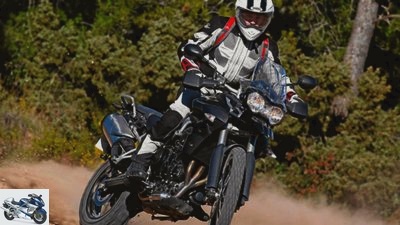

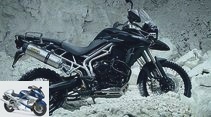
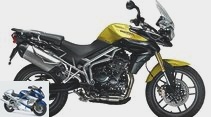

24 photos

triumph
1/24
Triumph Tiger 800: The three-cylinder engine generates 95 hp at 9300 rpm from 799 cubic meters.

triumph
2/24
Triumph Tiger 800 XC
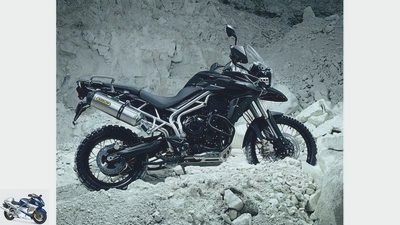
triumph
3/24
Triumph Tiger 800 XC with accessories: exhaust from Arrow.
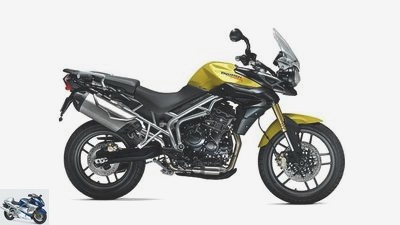
triumph
4/24
Triumph Tiger 800
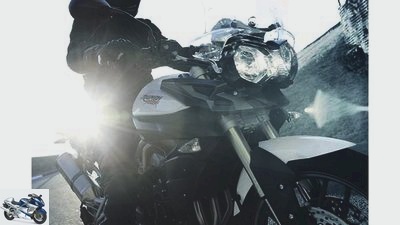
triumph
5/24
Triumph Tiger 800
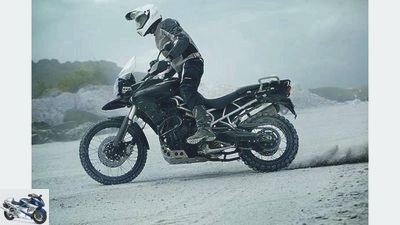
triumph
6/24
Triumph Tiger 800 XC
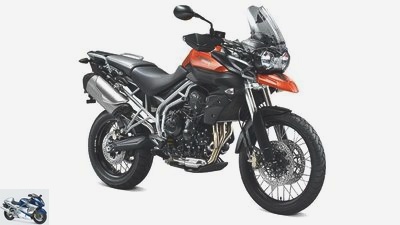
triumph
7/24
The off-road version of the Triumph Tiger 800 bears the suffix XC and, compared to the road version, has more suspension travel and a 21-inch wire-spoke front wheel.

triumph
8/24
Triumph Tiger 800 XC
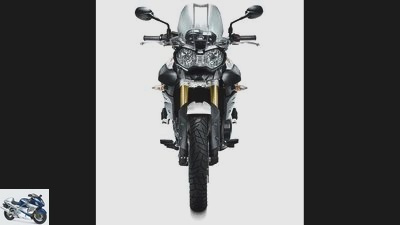
triumph
9/24
Triumph Tiger 800: Triumph specifies 79 Newton meters at 7850 rpm as the maximum torque.
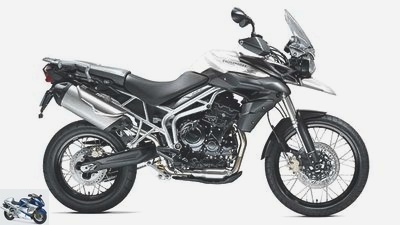
triumph
10/24
Triumph Tiger 800 XC: What both models have in common is an optional ABS that can be switched off.
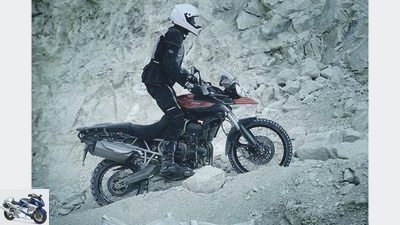
triumph
11/24
Triumph Tiger 800 XC
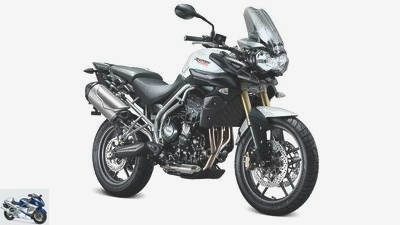
triumph
12/24
Triumph officially presented the new Tiger 800 travel enduro at the Eicma.
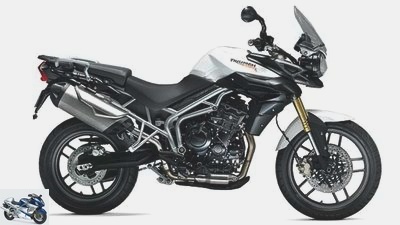
triumph
13/24
Triumph Tiger 800
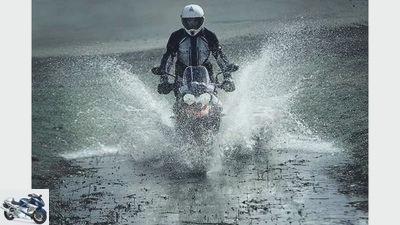
triumph
14/24
Triumph Tiger 800 XC

triumph
15/24
Triumph Tiger 800 XC – seat height: 845 to 865 millimeters.
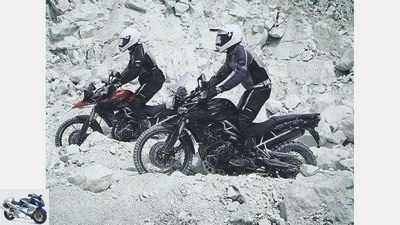
triumph
16/24
Triumph Tiger 800 XC
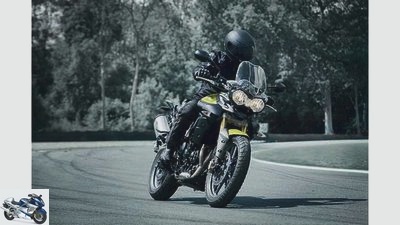
triumph
17/24
Triumph Tiger 800 – seat height: 810 to 830 millimeters.

triumph
18/24
Triumph Tiger 800 XC
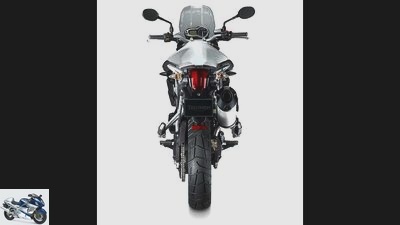
triumph
19/24
Triumph Tiger 800: With a tank capacity of 19 liters, nothing stands in the way of the big tour with the (basically not that small) new Tigers.
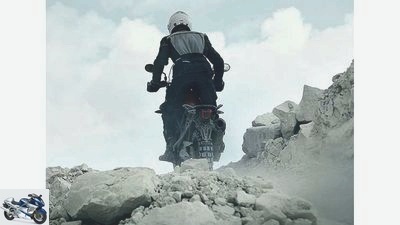
triumph
20/24
Triumph Tiger 800 XC
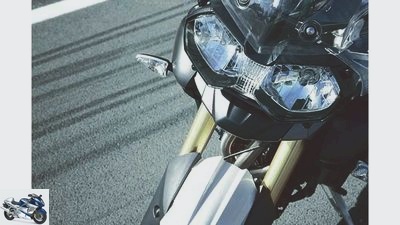
triumph
21/24
Triumph Tiger 800
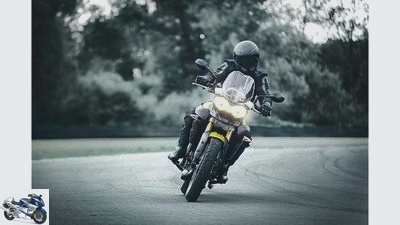
triumph
22/24
Triumph Tiger 800
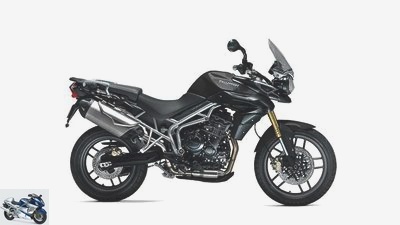
triumph
23/24
Triumph Tiger 800
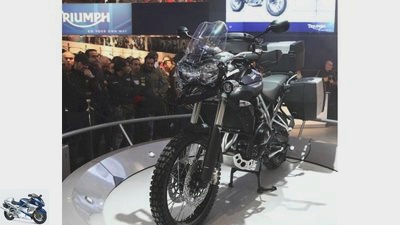
Gram
24/24
Triumph unveiled the Tiger 800 travel enduro at Eicma in Milan.
Driving report: Triumph Tiger 800 (XC)
Three-cylinder enduro from England
Only three and a half years passed between the first draft and the presentation of both Tiger versions. Now they are there. How, where and whether the new Triumph models work is something that MOTORRAD has tried out in Spain.
D.he information came in bits and pieces. For weeks, the British presented video snippets with driving sequences of the new 800 Tiger on their homepage. A motorcycle for adventure seekers that is available in two versions: while the basic version is intended to lure all country road fans, Triumph hopes to send a real opponent to the successful BMW GS models with the XC version. The videos were promising. So one could be curious. The tension was stoked on the eve of the first day of driving, because the same development team that was responsible for the sensational, 675 cubic three-cylinder also designed the 800 engine. You lie in bed with a big smile on your face.
Buy complete article

Driving report: Triumph Tiger 800 (XC)
Three-cylinder enduro from England
Triumph Tiger 800 XC – The all-terrain tiger: Longer suspension travel and better chassis components make the machine attractive for globetrotters too.
It is cured in the first few meters. The tiger shows its chocolate side. Light-footed and well-balanced, it can be maneuvered through jammed cars and follows gas commands immediately and without delay. Route, how was it? First right, second left, turn – missed. Screwed up. Here it goes on the highway. No matter. 130 km / h are allowed. And they are instantly on the digital speedometer. Now the three-cylinder turns a moderate 6,000 tours in sixth gear, which is designed as a real driving gear and not as a speed-saving overdrive. The wind protection of the small disc is surprisingly good, turbulence is limited and the bottom is well looked after for long distances. In addition, the engine runs silky smooth. So caressed, the Spanish landscape rushes past. You could go on like this forever. Forever.
First exit, further right curve. Fold down in an inclined position, target braking in front of the toll station. This is how motorcycling is fun. Everything fits, is in harmony. The coupling is perfectly controllable, smooth-running, and the gears slip without the Triumph-specific, bony, resinous shifting experience. Even the brakes shine with effective deceleration, even though all the motorcycles provided here were without ABS. The production of ABS machines will start in February 2011.
Pay the toll, fumble in your wallet, into the thicket of curves. Not every fan of the famous 675 engine, who was the godfather of the 800, will be impressed right away: The new three-cylinder does not act as greedily as its little brother. The lascivious rev up and the speed addiction of the 675 are alien to the 800 unit. It may be because it has a longer stroke, 85 percent of all components have been redrawn and the flywheel is probably larger. But if you have never driven the 675, you won’t miss anything. What the 800 does with the 210 kilogram Tiger is simply amazing. Between 2000 rpm and 9500 rpm, over 70 Newton meters should always be available, the maximum output of 95 hp is provided by the three-cylinder at 9300 rpm. That seems quite believable. It may read strange, but thanks to its exemplary elasticity, the Tiger can be driven almost like an electric vehicle. You drive off, can shift into fifth gear from 40 km / h and, provided you avoid traffic lights, leave it in for the rest of the journey.
Triumph Tiger 800 – The road tiger: Shorter suspension travel, different tires and the 19-inch front wheel enable fast asphalt chasing.
The trust-inspiring harmony between man and machine that the Tiger creates at the first contact is splendid. The steering behavior on the Pirelli Scorpion Sync is not ultra-handy, but the tire offers plenty of grip and good feedback thanks to its successful self-damping. The Tiger reacts calmly to steering corrections in an inclined position and does not become nervous. The turning circle – always a nuisance on the 675 Street Triple and Daytona models – is no longer an issue with the Tiger. Your steering angle enables turning maneuvers on the narrowest of roads. Even the feedback from the chassis components is surprising, as nothing can be adjusted in the standard version except the base of the shock absorber. The chassis design is a successful compromise between comfort and sport. The kilometers are unwound faster than desired and the bike is back in the hands of the British. The on-board computer reports an average consumption of 5.8 liters of super per 100 kilometers. That is acceptable. Good night.
Next morning. The XC version is ready. It looks bulky on its own. And it is, because your handlebars are wider, the chassis components are more stable, the spring travel longer (see info box on page 36) and the saddle is 35 millimeters higher. Take a shower – whoops, the bike climbs faster than you’d like – and off you go on an adventure. The first kilometers are unwound on-road. The off-road variant with its narrower but larger 21-inch front wheel and a total of five kilograms more weight steers a little more slowly than its sister.
The longer suspension travel allows for more movement in the chassis, but it never becomes really uncomfortable or even uncontrollable, even with committed cornering. The XC remains stable in all situations. And leaves a very balanced impression. While the basic Tiger deserves the term Funduro as a hybrid of Enduro, Supermoto and Naked Bike, the XC introduces itself as a friend who literally wants to ride through thick and thin with you.
Manufacturer
Crash bars to protect the engine and cooling system.
And that’s where it goes at the end. The XC can show its qualities on long gravel passages with moderate driveways and annoying lateral and longitudinal grooves. The spring elements are designed to be too soft for the rapid rush through the terrain, but the machine follows the steering impulse even when changing lanes. We especially like the very linear power output of the motor, drifts are easy and very controllable. When fully fueled, the Tiger looks a bit top-heavy, the division of the tank prevents strong gasoline sloshing and the associated disruptive impulses. And when you bend up on the road again after doing dozens of kilometers in the dirt, you get the feeling that it should have gone on forever. What more do you want than a machine that wants to go on holiday with you all the time and doesn’t complain even in bad weather?
At 10,540 euros including ABS and ancillary costs, the Tiger 800 XC (basic version: 9,740 euros) is slightly below the price of its only serious opponent, the BMW F 800 GS. Whether she is better than the Bavarian will show in the comparison test. But one thing is already certain: The Tiger 800 is a successful, maybe even a big hit. The German importer plans to sell a total of 1,000 copies in Germany in the coming year, and 7,500 machines worldwide. So the tigers won’t go extinct after all.
Click here for the Triumph Tiger video:
This is how the Triumph Tiger behaves in fifth gear:
Technical specifications
In travel trim: Triumph offers a generous luggage system with a maximum of 97 liters of storage space.
Triumph Tiger 800 (800 XC)
Engine:
Water-cooled three-cylinder four-stroke in-line engine, one balancer shaft, two overhead, chain-driven camshafts, four valves per cylinder, bucket tappets, wet sump lubrication, injection, 0 44 mm, regulated catalytic converter, alternator 645 W, battery 12 V / 14 Ah, mechanically operated multi-disc oil bath clutch , Six-speed gearbox, X-ring chain, secondary ratio 50:16.
Bore x stroke 74.0 x 61.9 mm
Displacement 799 cc
rated capacity 70.0 kW (95 PS) at 9300 rpm
Max. Torque 79 Nm at 7850 rpm
Landing gear:
Tubular tubular steel frame, upside-down fork, 0 43 (45) mm, two-arm swing arm made of aluminum, central spring strut with lever system, adjustable spring base (rebound adjustment), double disc brake at the front, 0 308 mm, four-piston fixed calipers, disc brake at the rear, 0 255 mm, single-piston – floating saddle, (optional ABS).
Cast aluminum wheels 2.50 x 19 (2.50 x 21); 4.25 x 17
Tires 100/90 ZR 19 (90/90 21); 150/70 ZR 17
Mass and weight:
Wheelbase 1555 (1568) mm, steering head angle 66.3 (66.9) degrees, caster 86 (91) mm, spring travel f / r 180/170 (220/215) mm, seat height 810-830 (845-865) mm, Weight with a full tank * 210 (215) kg, tank capacity 19.0 liters.
guarantee two years
Colours White, black, yellow
price* 9740 (10540) euros
*Incl. Additional costs and ABS
The differences
Both Tigers use the same frame and engine, but there are still some differences.
Although the frame and motor are identical on both machines, the small differences optimize the bikes for their special areas of use:
rims: The off-road version has black anodized Excel rims with spokes, the basic Tiger rolls on cast aluminum rims. The front wheel dimensions are also different: a 21-inch wheel (tire size: 90/90) is used by the XC, a 19-inch wheel (tire size: 100/90) is used by the normal Tiger.
fork: The XC has 45 mm stanchions with 220 millimeters of travel, the standard has to be content with a 43 mm fork and 170 millimeters.
fender: The XC splash guard is shaped like a beak based on the competition.
Handlebars and Risers: Wider handlebars and higher risers are used on the XC.
Hand protectors: They are included in the price of the XC, but also fit the standard.
Strut: With 215 millimeters of spring travel plus rebound and spring base adjustment as well as a reservoir, the XC is equipped for tougher use, while the standard has to make do with a counterpart with just 170 millimeters of spring travel and only adjustable spring base.
The changing of the guard?
archive
MOTORRAD editor and ex-globetrotter Rolf Henniges.
MOTORRAD editor and ex-globetrotter Rolf Henniges on Triumph’s chances of beating market leader BMW with the Tiger 800 XC in the top disciplines.
Let’s not kid ourselves: Most of the outback tracks are in great condition, in South America slopes are constantly being graveled, and even from Africa there are reports of improved road conditions. Experienced pilots can do many long-distance trips just as well with a Honda CBF 600 these days. Nevertheless, not only real, but also many potential adventure freaks still want to be equipped for all road and slope conditions and to ride a motorcycle that visually represents the much-invoked adventure spirit. So far, when buying a new one, you had to choose between the Yamaha XTZ 660 Tenere (215 kg, 48 hp) and the BMW F 800 GS (222 kg, 85 hp). Most of the long-distance travel freaks opted for the GS. In my opinion, the new Tiger 800 XC (215 kg, 95 PS) is not only an alternative to both models, but also the better choice for long-distance travel.
Why? It surprises with similarly good seating comfort and the long-distance suitability of a BMW R 1200 GS, is at least as off-road as the BMW F 800 GS, and on top of that, the 800 cubic three-cylinder is a model of smoothness. Its harmonious torque output and power delivery are impressive in this segment and raise the bar higher.
With the XC, Triumph has the best prerequisites for worldwide sales success. Many people like the brand, the motorcycle works flawlessly, doesn’t have to hide from the competition and sets the tone. I am curious whether the buyer clientele will see it too.
Related articles
-
Driving report: Triumph Tiger 800
Muller 24 photos triumph 1/24 Triumph Tiger 800: The three-cylinder engine generates 95 hp at 9300 rpm from 799 cubic meters. triumph 2/24 Triumph Tiger…
-
Driving report Triumph Tiger 800 XR, XC, XRx and XCX
Triumph 8 pictures Triumph 1/8 A small step for mankind, a big step for the Tiger 800 … Triumph 2/8 The electronic upgrade and …
-
Driving report Triumph Tiger 800 XCx and XRx
triumph 31 photos triumph 1/31 triumph 2/31 triumph 3/31 triumph 4/31 triumph 5/31 triumph 6/31 triumph 7/31 triumph 8/31 triumph 9/31 triumph 10/31…
-
Triumph Rocket III in the driving report: more and less
Triumph 9 pictures Triumph 1/9 Even more displacement and Newton meters, but at the same time the weight screwed down. Does not sound bad. Triumph 2/9 …
-
Driving report Triumph Tiger 1200 XRt-XCa
Triumph 27 pictures Triumph 1/27 Triumph Tiger 1200 XCa. Triumph 2/27 Triumph Tiger 1200 XCa. Triumph 3/27 Triumph Tiger 1200 XCa. Triumph 4/27 Triumph …
-
Driving report Triumph Tiger 1050 (2006)
Jahn Driving report Triumph Tiger 1050 (2006) The eternal hunting grounds Lying in wait, stalking, stalking, that’s what hunting is all about. In order…
-
Jahn Top-Test Triumph Tiger 955i The mild cat Tigers are aggressive, strong and stubborn. Commonly regarded as wild, indomitable creatures with …
-
Driving report Triumph Thunderbird Sport
Driving report Triumph Thunderbird Sport A weird bird The Triumph Thunderbird as an athlete? Do a more powerful engine and firmer landing gear really…
-
Driving report Triumph Tiger 800 XC-XR 2018
Triumph 44 pictures Makus Jahn 1/44 With many detail changes, Triumph is sharpening the Tiger 800 for the 2018 model year. Markus Jahn 2/44 …
-
Triumph Tiger Explorer XCA in the driving report
Triumph 18 pictures Triumph 1/18 As far as the optics are concerned, the Triumph Tiger Explorer hasn’t changed much, … Triumph 2/18 The …